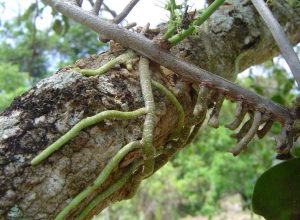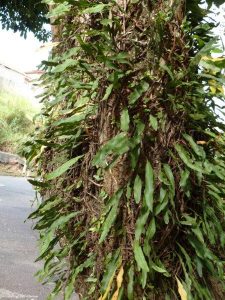Mistletoe herb is a natural parasite but contains various medicinal properties and important benefits for people. It acts against respiratory tract diseases in both children and adults and can be easily found, either dried or fresh.
The Plant
Struthanthus flexicaulis1, popularly known as mistletoe herb, is so named because birds are mainly responsible for spreading it. This plant is native to Brazil. From the Loranthaceae family, it also goes by names such as bird graft, little bird plant, and mistletoe. Mistletoe herb is considered a pest in the wild. With parasitic and dominant characteristics over other plant species and trees, mistletoe herb settles on the trunk, sucking all the nutrients and sap from the host plant, and can even cause its death due to lack of nutrients, if not controlled in time. Mistletoe herb grows easily and looks like roots along the trunks. When it grows on the ground, it becomes a strong mistletoe, hard to remove. The branches of the mistletoe herb spread wherever they can find a place to settle. Because it is so resilient, it is used as a base for the nests of some small bird species and also some insects. Rich in chlorophyll, the plant is ideal for photosynthesis, but for this, it still depends on another plant to supply nutrients. Some religions use mistletoe herb as a talisman for spiritual protection.
Medicinal Properties
Recommended for both internal and external use for adults and children, mistletoe herb is used to aid recovery from various illnesses, mainly those of the respiratory system2. Its tea has been scientifically proven effective in cases of bronchitis, asthma, pneumonia, and pulmonary emphysema. It helps reduce chest pain, especially those caused by gas and acute infection crises like pneumonia and whooping cough. Mistletoe herb also combats:
Hemoptysis: Bleeding associated with coughing is called hemoptysis and is related to hemorrhage in the alveolar tree of the lungs. Serious illnesses like pulmonary emphysema can frequently present these bleeds. Mistletoe herb helps reduce the frequency of these episodes until the discomfort disappears completely.
Pleurisy: The pleura is the membrane covering the entire lung, and pleurisy is an infection of that membrane. Mistletoe herb aids in the recovery from this infection and helps protect against future recurrences.
Uterine Problems: Mistletoe herb also possesses important medicinal properties for uterine issues. It is useful for wounds requiring cauterization, vaginitis, sexually transmitted diseases, and fungal infections. Mistletoe herb tea also helps control menstrual bleeding. Very long menstrual cycles with heavy flow can cause abdominal pain and may lead to hemorrhage. The herb acts with its enzymes to help reduce both pain and flow.
How to Use
Mistletoe herb is used in the form of teas to fight diseases, but can also be used as a compress to reduce fevers. The benefits of mistletoe herb are essential in syrups for cases of cough with phlegm or mucus from strong bronchitis or flu. The plant juice is also used for uterine problems, it is recommended to use two to three glasses of the juice made from five tablespoons of mistletoe herb bark blended with one liter of water. The juice dosage for children should be one third of the adult dose, that is, from half to one glass per day.
The parts used to make mistletoe herb tea are the leaves and the roots attached to the tree trunk, as these are the most vitamin-rich parts of the plant and can be used dried or fresh to make tea or juice.
How to Make the Tea
To prepare mistletoe herb tea, use two heaping tablespoons of the bark in a liter of filtered, boiling water. It is advised to boil the herb on low heat for about 10 minutes. Cover for another five minutes, then sweeten to taste before consuming. Drink the tea two or three times a day; the dose for children, as with the tea and juice, should be one third of the adult dose. Honey can be used to sweeten the tea as long as there is no allergy to it. It is also recommended to add citrus fruits to make the tea tastier.

Precautions with Mistletoe Herb
If you wish to cultivate mistletoe herb at home, you should be cautious because it is a very robust species. Controlling its spread has caused headaches for entire cities in states where the climate favors its growth and proliferation. The only way to eliminate or reduce the growth of mistletoe herb is complete or partial periodic pruning. There is evidence that mistletoe herb is easier to control when the species displays larger leaves. Species with smaller leaves may reappear on the same trunk where growth was previously controlled. If, even after complete pruning, the plant grows back, it will be necessary to scrape the tree infested by the plant.












